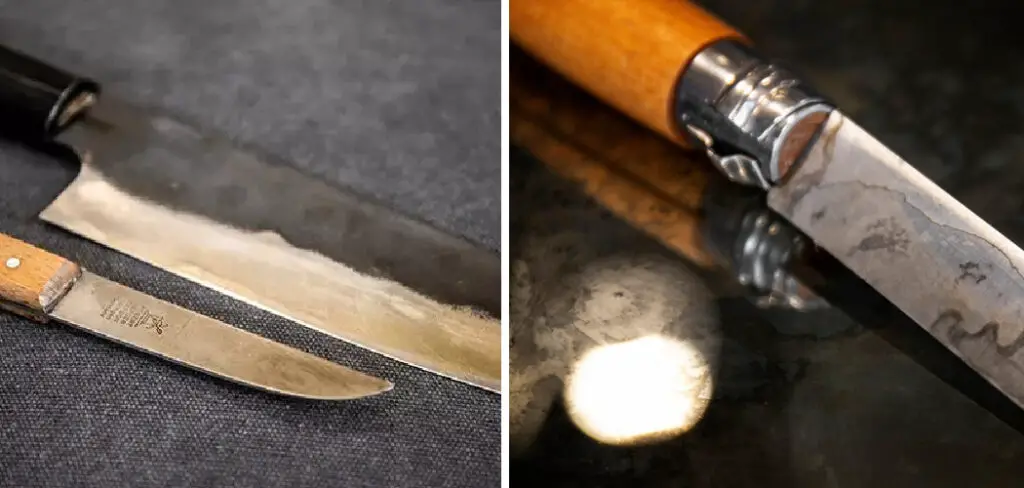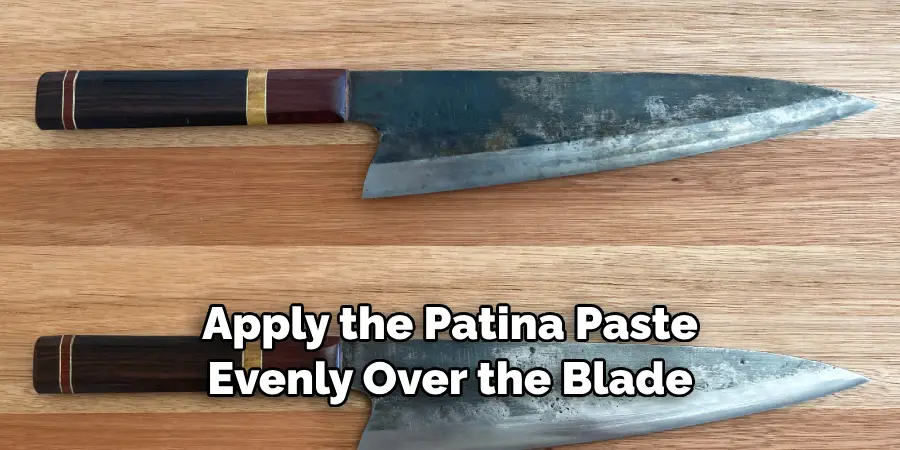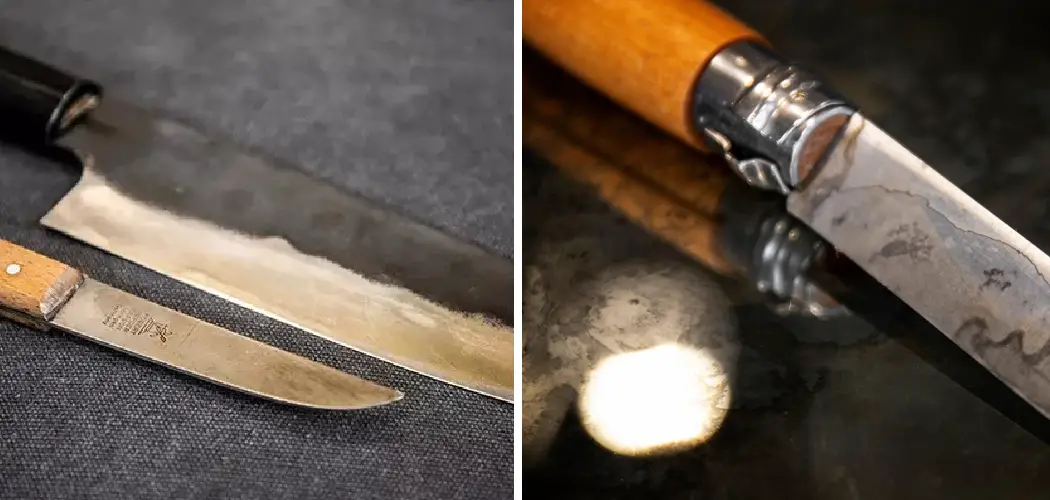Do you love the unique patina that can be achieved on Carbon Steel blades? If so, then this blog post is for you! We will explain how to put patina on Carbon Steel knife with just a few simple steps.

You’ll learn about the sought-after blue-purple hue it creates and why it’s important to protect any metal pieces from rusting or tarnishing over time. With our techniques, you can create stunning results in no time at all – talk about an instant upgrade! Plus, we’ll show you some tips for the trade along the way to make sure all your precious metals stay sparkling and beautiful forever!
Step-by-Step Guidelines on How to Put Patina on Carbon Steel Knife
Step 1: Prepare the Patina Paste
The most popular type of patina for Carbon Steel knives is a 50/50 mixture of water and white vinegar with a tablespoon of salt added. This should be mixed together until it forms an even liquid consistency, then put aside in an easily-accessible container. Preparing the paste in advance ensures that you’re not trying to mix it up while your knife is already covered in patina!
Step 2: Apply the Patina Paste
Using a soft cloth or an old toothbrush, begin to apply the patina paste evenly over the blade of your Carbon Steel knife. Be sure to cover all areas, but avoid getting any paste on the handle. While applying, you should notice a light blue-purple hue starting to appear as the patina sets in, and make sure to keep the paste on for at least five minutes.

Step 3: Allow the Patina Paste to Work Its Magic
Allow the patina paste to sit on your Carbon Steel knife for at least 15 minutes, although you can leave it for up to 30 minutes to get a deeper color. During this time, gently dab or brush away any excess paste that may be pooling in areas. If you want to get even more of an aged look, you can add some extra layers of patina paste and allow them to dry before wiping them off.
Step 4: Clean and Dry the Knife
Once your desired color is achieved, the next step is to rinse off the patina paste with warm water. Don’t be alarmed if you see a bit of discoloration when rinsing; this is normal. Afterward, make sure to dry the knife off with a soft cloth and check for any spots that may have been missed.
Step 5: Seal and Protect Your Carbon Steel Knife
The last step in putting patina on your Carbon Steel knife is to seal it in order to protect it against rusting or tarnishing. You can do this with a metal sealant, such as WD-40 or mineral oil. This will also help to ensure that the unique patina you’ve created on your Carbon Steel knife stays in place for years to come!
Now you know how to put a patina on a Carbon Steel knife with ease. With this easy-to-follow tutorial, you’ll be able to create stunning results in no time at all! Enjoy your new look and make sure to keep those metals sparkling forever. Happy patina-ing!
Additional Tips and Tricks to Put Patina on Carbon Steel Knife
- Putting a patina on carbon steel knives requires patience and practice. It is important to keep in mind that the process of putting a patina on a knife takes time and effort, and it will take multiple steps before you achieve your desired results.
- You should work in an area with adequate ventilation when performing this task, as there may be strong fumes from the chemicals used during patina application.
- Always wear protective gloves and eye protection when handling acid, solvents, or other materials related to the patina application.
- Before applying a patina to your knife blade, it is important to properly clean the blade’s surface and remove any oils that may be present on the blade. This will ensure the patina is properly applied and won’t be affected by any lingering oils.
- You can use a variety of methods to apply the patina, but the most common techniques include applying acid or vinegar directly to the blade, heating it in an oven with oil, or sanding the blade with fine gritty paper until it becomes darkened.
- It is important to note that different types of patinas will require different methods of application, so make sure you research the type of patina you are looking for before beginning your project.
- After applying a patina, it is essential to properly care for and maintain the blade by oiling or waxing it regularly to ensure it remains in good condition.
- Finally, the patina can be removed from a blade if you are ever looking to change its appearance. Simply use steel wool or fine-grit sandpaper and scrub the patina off the blade until you reach your desired result.

By following these simple tips and tricks, you will be able to successfully put a patina on your carbon steel knife. With a little patience and practice, you’ll be able to create a unique and sleek look that will last for years to come!
Things You Should Consider to Put Patina on Carbon Steel Knife
1. Choose the Right Steel:
Carbon steel is an ideal material for adding patina to knives, as it reacts quickly and predictably with many different substances. However, not all carbon steels are created equal – some may be more prone to rusting or reaction than others. It’s important to research and understands the type of steel you have before attempting a patina.
2. Understand the Risks:
Adding patina to knives can have both positive and negative effects, depending on the methods used and the type of steel. The acids and chemicals used may cause discoloration or staining that cannot be reversed. Additionally, some patinas are not as durable as others and may need to be reapplied frequently to maintain the desired effect.
3. Gather Patina-Applying Materials:
Depending on the patina you choose, there are several materials that must be gathered in order to apply them to your carbon steel knife. These include distilled white vinegar, lemon juice, mustard powder, raw egg, and a variety of other acids or chemicals. You’ll also need to allocate a proper workspace and have several pieces of newspaper or plastic sheeting ready for covering.
4. Prepare the Knife:
Before beginning the patina application process, the knife should be thoroughly cleaned with soap and warm water. Any dirt, grease, or debris must be removed in order for the patina to take hold. Additionally, use caution when handling sharp edges to prevent injury.

5. Apply the Patina:
Finally, you can begin applying the patina of your choice. Depending on the method used, it may require multiple coats or treatments. Be sure to follow instructions carefully and take all necessary safety precautions when handling chemicals. Allow each coat time to dry before adding another, and remember to keep an eye on any discoloration that could affect the aesthetic of your knife.
Following these considerations can help ensure that applying patina to your carbon steel knife is a safe and successful process. With the right materials, preparation, and attention to detail, you can create a unique and lasting look for any knife or blade.
Frequently Asked Questions
What is Patina?
Patina is a thin layer of corrosion that forms over time on the surface of carbon steel knives. This layer can range from light brown to deep black and provides a protective coating, making it more resistant to rusting and corrosion.
What is the Best Way to Put Patina on a Carbon Steel Knife?
The best way to put a patina on a carbon steel knife is by exposing it to moisture and oxygen. This can be done either with natural elements like rain or water or by using chemical solutions such as vinegar or lemon juice. For added protection, you can also use oiling and waxing methods. It’s important to remember that patina is a natural process, so it will take time for the knife to develop its own unique look.

Will Patina Make My Knife Look Better?
Yes, the patina will make your knife look better. It can give the blade a beautiful and unique look as well as make it more resistant to rust and corrosion. With proper care and maintenance, your knife will remain in good condition for many years to come.
How Long Does it Take to Put Patina on a Carbon Steel Knife?
The amount of time it takes to put a patina on a carbon steel knife can vary greatly, depending on the type of patina being applied and the method used. Generally, it will take several treatments over multiple days before the desired effect is achieved. With patience and practice, you’ll soon be able to create a custom patina that you’ll love.
Conclusion
Hopefully, with the above outlined, you can understand how to put patina on a carbon steel knife and some of the benefits that come with it. Patina is an important part of maintaining your knife properly and ensuring that it looks great for many years to come. If you take care of your knives, they will return the favor by taking care of you!

